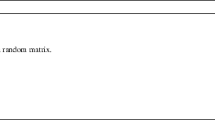Abstract
Non-negative matrix factorization (NMF) is a method to obtain a representation of data using non-negativity constraints. A popular approach is alternating non-negative least squares (ANLS). As is well known, if the sequence generated by ANLS has at least one limit point, then the limit point is a stationary point of NMF. However, no evdience has shown that the sequence generated by ANLS has at least one limit point. In order to overcome this shortcoming, we propose a modified strategy for ANLS in this paper. The modified strategy can ensure the sequence generated by ANLS has at least one limit point, and this limit point is a stationary point of NMF. The results of numerical experiments are reported to show the effectiveness of the proposed algorithm.
Similar content being viewed by others
Explore related subjects
Discover the latest articles, news and stories from top researchers in related subjects.References
Ahn J-H, Kim S-K, Oh J-H, Choi S (2004) Multiple nonnegativematrix factorization of dynamic PET images. In ACCV
Brunet J-P, Tamayo P, Golub T R, Mesirov J P (2004) Metagenes and molecular pattern discovery using matrix factorization. Proc Nat Acad Sci USA 101: 4164–4169
Cho Y-C, Choi S (2005) Nonnegative features of spectro-temporal sounds for classification. Pattern Recognit Lett 26: 1327–1336
Chu M, Diele F, Plemmons R, Ragni S (2004) Optimality, computation, and interpretations of nonnegative matrix factorizations. SIAM J Matrix Anal 4–8030
Gao Y, Church G (2005) Improving molecular cancer class discovery through sparse non-negative matrix factorization. Bioinformatics 21: 3970–3975
Gonzalez EF, Zhang Y (2005) Accelerating the Lee-Seung algorithm for nonnegative matrix factorization, Technical report, Rise University
Guillamet D, Vitria J (2002) Classifying faces with nonnegative matrix factorization. In Proceedings of the Fifth Catalan Conference for Artificial Intelligence
Guillamet D, Schiele B, Vitria J (2002) Analyzing non-negative matrix factorization for image classification. 16th International Conference on Pattern Recognition, vol 2, pp 116–119
Guillamet D, Vitria J, Schiele B (2003) Introducing a weighted non-negative matrix factorization for image classification. Pattern Recognit Lett 24: 2447–2454
Kim H, Park H (2007) Sparse non-negative matrix factorizations via alternating non-negativity-constrained least squares for microarray data analysis. Bioinformatics 23: 1495–1502
Kim H, Park H (2008) Nonnegative matrix factorization based on alternating nonnegativity constrained least squares and active set method. SIAM J Matrix Anal Appl 30: 713–730
Kim PM, Tidor B (2003) Subsystem identification through dimensionality reduction of large-scale gene expression data. Genome Res 13: 1706–1718
Kim D, Sra S, Dhillon IS (2007) Fast newton-type methods for the least squares nonnegative matrix approximation problem. In: Proceedings of SIAM Conference on Data Mining
Lee DD, Seung HS (1999) Learning the parts of objects by non-negative matrix factorization. Nature 401: 788–791
Lee DD, Seung HS (2001) Algorithms for non-negative matrix factorization. In: Proceedings of Neural Information Processing Systems, vol 13, pp 556–562
Lee JS, Lee DD, Choi S, Lee DS (2002) Application of nonnegative matrix factorization to dynamic positron emission tomography. In 3rd International Conference on Independent Component Analysis and Blind Signal Separation, pp 556–562
Li H, Adali T, Wang W, Emge D (2005) Non-negative matrix factorization with orthogonality constraints for chemical agent detection in raman spectra. Machine Learning for Signal Processing, pp 253–258
Lin C-J (2007) Projected gradient methods for nonnegative matrix factorization. Neural Comput 19: 2756–2779
Lin C-J (2007) On the convergence of multiplicative update algorithms for non-negative matrix factorization. IEEE Transac Neural Netw 18: 1589–1596
Liu W, Zheng N (2004) Non-negative matrix factorization based methods for object recognition. Pattern Recognit Lett 25: 893–897
Okun O, Priisalu H (2009) Fast nonnegative matrix factorization and its application for protein fold recognition. EURASIP J Appl Signal Process 2006: 62
Paatero P (1999) The multilinear enginea table-driven least squares program for solving multilinear problems, including the n-way parallel factor analysis model. J Comput Graph Stat 8: 1–35
Paatero P, Tapper U (1994) Positive matrix factorization: a non-negative factor model with optimal utilization of error estimates of data values. Environmetrics 5: 111–126
Pascual-Montano A, Carazo JM, Kochi K, Lehmann D, Pascual-Marqui RD (2006) Nonsmooth nonnegative matrix factorization (nsNMF). IEEE Transac Pattern Anal Mach Intell 28: 403–415
Paul Pauca V, Shahnaz F, Berry Michael W, Plemmons Robert J (2004) Text mining using non-negative matrix factorization. In: Proceedings of the Fourth SIAM International Conference on Data Mining 2004
Rao N, Shepherd SJ (2004) Extracting characteristic patterns from genomewide expression data by non-negative matrix factorization. In Computational Systems Bioinformatics Conference
Richardson WH (1972) Bayesian-based iterative method of image restoration. J Opt Soc Am 62: 55–59
Spratling MW (2006) Learning image components for object recognition. J Mach Learn Res 7: 793–815
Wang Y, Jia Y, Hu C, Hu C (2005) Non-negative matrix factorization framework for face recognition. Int J Pattern Recognit Artif Intell 19: 495–511
Zdunek R, Cichocki A (2006) Non-negative matrix factorization with quasi-newton optimization. International Conference on Artificial Intelligence and Soft Computing (ICAISC 2006), pp 870–879
Zdunek R, Cichocki A (2008) Fast nonnegativematrix factorization algorithms using projected gradient approaches for large-scale problems. Hindawi Publishing Corporation Computational Intelligence and Neuroscience
Author information
Authors and Affiliations
Corresponding author
Additional information
Responsible editor: Chih-Jen Lin.
Rights and permissions
About this article
Cite this article
Liu, H., Li, X. & Zheng, X. Solving non-negative matrix factorization by alternating least squares with a modified strategy. Data Min Knowl Disc 26, 435–451 (2013). https://doi.org/10.1007/s10618-012-0265-y
Received:
Accepted:
Published:
Issue Date:
DOI: https://doi.org/10.1007/s10618-012-0265-y




